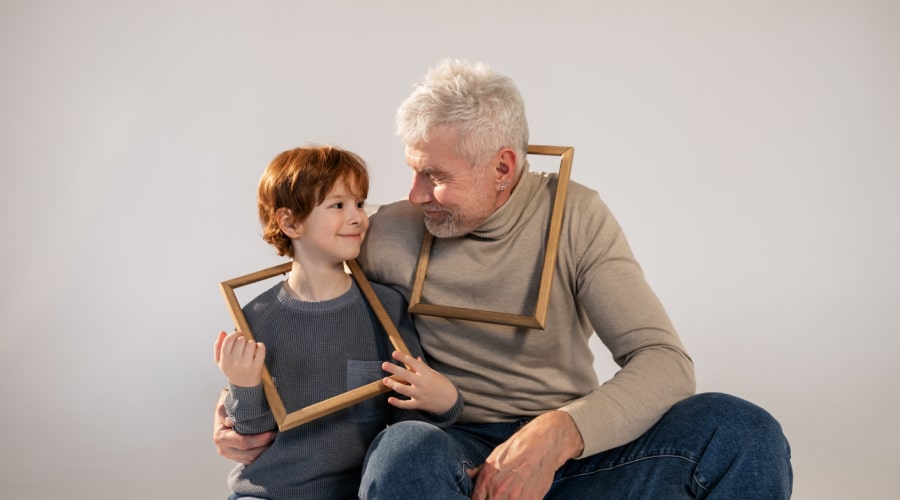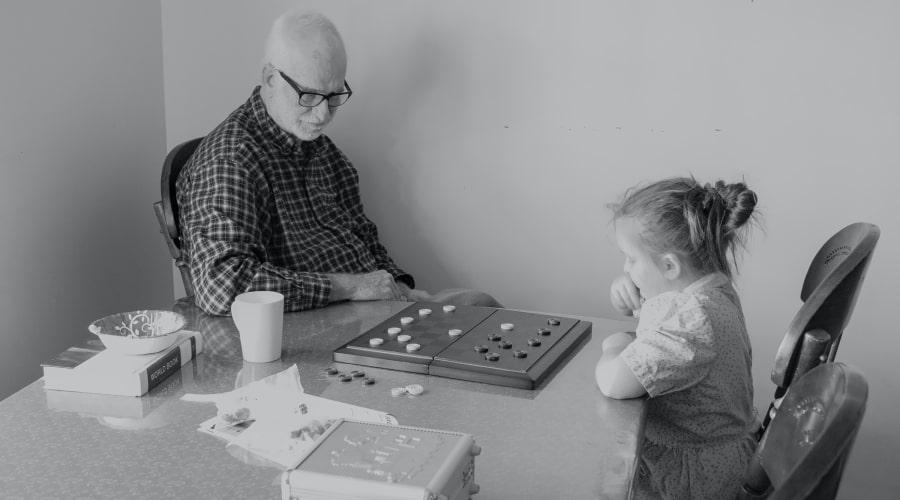settings
children
With Famly since
The relationships between children and seniors can be both rewarding and inspiring, but to get the most out of them we need to move beyond the idea of children as ‘performers’ and seniors as ‘onlookers’. Nobody would disagree that children love to perform and seniors love to watch them, but if this is all we do together, then we miss opportunities to foster real depth and connection. A more thoughtful approach to intergenerational activities will return huge rewards for both the children and seniors involved.
The youngest and the oldest members of our society have a surprisingly large amount in common, not just in terms of physical restrictions, but also in their attitude of wonder, emotional honesty and delight in company and attention. If we create the right activities, these relationships will flourish and offer unique opportunities for children to learn compassion, inclusivity and understanding of the cycle of birth, growth and aging.
As a person who has recently moved from the care home sector into the early years sector, I hope I can bring a new perspective to bridging the gap between the youngest and most senior members of our community.
So how should we go about designing activities to make sure we create these powerful intergenerational relationships?
Well, it’s mostly about not overthinking it.

How to get the most out of intergenerational relationships
The most important factor you should consider is the timing and length of your activities. A common pattern with these intergenerational relationships is infrequent visits, often for a singing or performance activity delivered at irregular intervals. Whilst these have their own value and are usually really enjoyed by both the children and seniors involved, the real benefits of intergenerational work come out when activities allow real and meaningful relationships to develop. That happens through short but regular sessions.
Activities with children and seniors offer their brightest benefits when they are regular and sustained, and a relationship can begin to develop between old and young. Most children don’t live in multigenerational households anymore, and opportunities to bond with seniors offer them a priceless experience:
- For seniors the opportunity to share their memories and crucially, to teach and inspire others again can also be a rich experience. It evokes memories of raising their own children, but also restores a sense of pride and legacy that is vital to wellbeing.
- For children, especially those who don’t have the benefit of grandparents or other seniors in their lives, helping them build relationships with familiar seniors provides crucial cultural capital and allows them to develop a sense of the natural cycle of life.
What makes children and seniors such a good match?
We’re often nervous about taking children from our safe nursery environments, or seniors from their bespoke and modified homes. But actually, both parties thrive in very similar environments. A senior and a preschooler will probably be well matched for a walk outdoors, and both will be delighted to feed some ducks. What can be a learning activity for children is a reminiscence activity for seniors.
Let’s look at more ways that children and seniors can be good matches for one another:
- They’ve got similar comfort needs. Both children and seniors will need adequate shade, similar warmth of clothes or sunhats and sun cream for delicate skin.
- They enjoy the same environments. Children and seniors will do well in low-ambient-noise environments. Seniors prefer these because they may suffer some hearing loss with age, while calm environments offer children better concentration and engagement.
- Mealtimes look about the same for everyone. Children and seniors have a similar need for regular fluids and snacks to keep their energy levels up. Whilst allergies are a key concern for children, food texture and sensitivities are really important for seniors, so make sure food and drink is kept separate and given only by the carers for that person, young or old.
- They can have similar physical limits. A huge benefit to children is that they can meet people who use assistive aids like wheelchairs, frames or hearing aids. This is a great opportunity to teach children about this equipment, its purposes and why people need it. A great activity to promote this might be a decorating competition for children and seniors, with the best decorated wheelchair or frame getting a prize.

The best activities to share between children and seniors
Think about activities that allow young and old to cooperate and achieve together. The most obvious and successful of these is gardening together. Seniors can show their huge knowledge, and children will be delighted to dig around in the soil. It can be simply some fun in the moment, or a serious long-term collaboration between children and seniors. It has great health and well-being benefits and gives lots of great learning opportunities, even better if seniors are the ones doing the teaching.
If you’re able to share a garden, it’s good to ask questions that allow the seniors to teach. You might ask:
- What colour will this plant be when it has flowers?
- What plants go next to each other?
- What tastes good to eat?
These are all simple questions that seniors can answer with confidence.
Another great intergenerational activity is work around making and creating. Children and seniors will have similar levels of dexterity, so shared crafts can work really well together. Working together for a higher purpose has proven benefits, so consider making bird seed cakes or simple bird houses for our feathered friends. Maybe creating dog biscuits for the local animal shelter and making simple Christmas decorations to decorate a tree or table are also popular activities.
Basically, if children enjoy it in the nursery, seniors will find it pitched more or less at their level of physical skill. With similar levels of focus and attention, you will find seniors and children pair well together in these activities.

Sharing memories through intergenerational care
One of the most precious ways seniors and children can interact is through sharing and learning memories. It’s a tradition as old as time for seniors to tell their life stories to children, and it’s a source of huge fascination for children as they use the stories to grapple with a sense of time and history.
But how do you turn this ritual into an everyday activity? One very beautiful idea is to help a senior create a memory box. Ask them to prepare photographs of themselves as a child. Include pictures of their house and information about their school or teachers.
Then, have some conversational prompts at the ready:
- What were you good at when you were at school?
- What food did you hate, what were your favourite sweeties and how did they taste?
- Tell us a song you used to sing when you were little.
Questions like these can foster a sense of connection between child and senior.
Finally I would just say that promoting these kinds of activities takes some planning and consideration. It will probably need a lot of collaboration to make it work initially, but the role seniors can play in the development of a child is irreplaceable. The good news is that most care homes will be delighted to foster these relationships. Contact the manager of your local care home and start a conversation about how you could work together to build these relationships. Propose a joint trip, a community garden, or a fundraiser for charity and you will probably be surprised at how eager they will be to work in partnership with you. When these activities go well and children develop collaborative and friendly relationships with seniors there is no more delightful thing to see. It’s a relationship where everyone wins.
The big ideas
Try learning journals for free
Add observations, and build digital learning journals to share with families instantly. All with your completely free 14-day trial.
Get started









